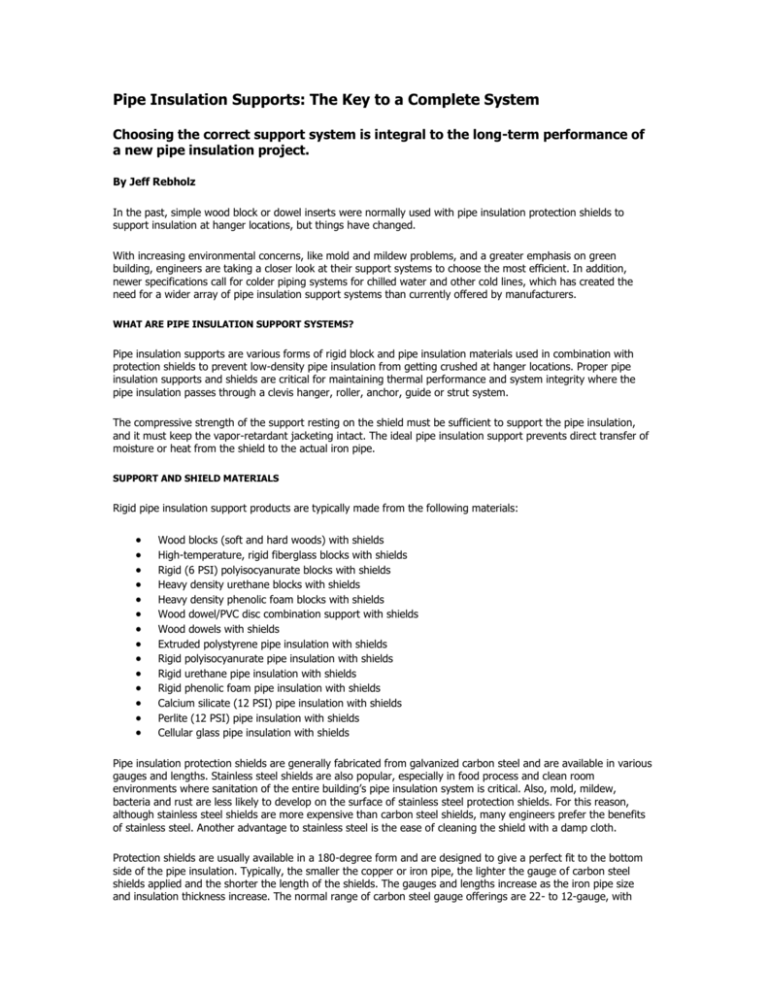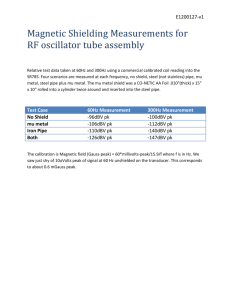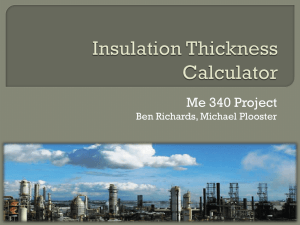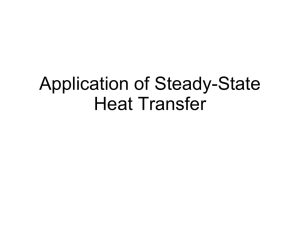Pipe Insulation Supports: The Key to a Complete System
advertisement

Pipe Insulation Supports: The Key to a Complete System Choosing the correct support system is integral to the long-term performance of a new pipe insulation project. By Jeff Rebholz In the past, simple wood block or dowel inserts were normally used with pipe insulation protection shields to support insulation at hanger locations, but things have changed. With increasing environmental concerns, like mold and mildew problems, and a greater emphasis on green building, engineers are taking a closer look at their support systems to choose the most efficient. In addition, newer specifications call for colder piping systems for chilled water and other cold lines, which has created the need for a wider array of pipe insulation support systems than currently offered by manufacturers. WHAT ARE PIPE INSULATION SUPPORT SYSTEMS? Pipe insulation supports are various forms of rigid block and pipe insulation materials used in combination with protection shields to prevent low-density pipe insulation from getting crushed at hanger locations. Proper pipe insulation supports and shields are critical for maintaining thermal performance and system integrity where the pipe insulation passes through a clevis hanger, roller, anchor, guide or strut system. The compressive strength of the support resting on the shield must be sufficient to support the pipe insulation, and it must keep the vapor-retardant jacketing intact. The ideal pipe insulation support prevents direct transfer of moisture or heat from the shield to the actual iron pipe. SUPPORT AND SHIELD MATERIALS Rigid pipe insulation support products are typically made from the following materials: Wood blocks (soft and hard woods) with shields High-temperature, rigid fiberglass blocks with shields Rigid (6 PSI) polyisocyanurate blocks with shields Heavy density urethane blocks with shields Heavy density phenolic foam blocks with shields Wood dowel/PVC disc combination support with shields Wood dowels with shields Extruded polystyrene pipe insulation with shields Rigid polyisocyanurate pipe insulation with shields Rigid urethane pipe insulation with shields Rigid phenolic foam pipe insulation with shields Calcium silicate (12 PSI) pipe insulation with shields Perlite (12 PSI) pipe insulation with shields Cellular glass pipe insulation with shields Pipe insulation protection shields are generally fabricated from galvanized carbon steel and are available in various gauges and lengths. Stainless steel shields are also popular, especially in food process and clean room environments where sanitation of the entire building’s pipe insulation system is critical. Also, mold, mildew, bacteria and rust are less likely to develop on the surface of stainless steel protection shields. For this reason, although stainless steel shields are more expensive than carbon steel shields, many engineers prefer the benefits of stainless steel. Another advantage to stainless steel is the ease of cleaning the shield with a damp cloth. Protection shields are usually available in a 180-degree form and are designed to give a perfect fit to the bottom side of the pipe insulation. Typically, the smaller the copper or iron pipe, the lighter the gauge of carbon steel shields applied and the shorter the length of the shields. The gauges and lengths increase as the iron pipe size and insulation thickness increase. The normal range of carbon steel gauge offerings are 22- to 12-gauge, with lengths normally at 8 inches, 12 inches, 18 inches and 24 inches for iron pipe sizes ranging from one-half–inch to 36 inches in diameter. Pipe insulation shield quality has improved during the past few years. Flared edge shields were designed to protect the vapor-retardant jacket facing from being punctured, and center-ribbed shields have been made available by the major clevis hanger and shield manufacturers for several years. These ribbed shields give the perfect fit inside the clevis hanger and help prevent the shield from sliding out of the clevis hanger during pipe movement. Plated shields are used with applications that require roller hangers. The additional plate is centered on the underside of the shield, which gives extra structure and stability to the pipe insulation support system. The plate is generally made of 1/4–inch thick hardened steel and is spot-welded to the adjoining, lighter carbon steel shield. In recent years, pre-insulated shields have become more popular, featuring a combination of rigid insulation, vapor-retardant jacketing and a self-seal tape to ensure a tight vapor-retardant closure system and a protection shield. Some specifications call for a 360-degree over/under shield to give complete protection around the entire area of the pipe insulation support. The advantage to pre-insulated shields is that they are simple and ready to install versus field-fabricated blocks and dowels, which have to be inserted into the pipe insulation before the actual installation. WHO INSTALLS SUPPORT SYSTEMS? Either the insulation contractor or the mechanical contractor installs pipe insulation supports, but this depends on the requirements of the mechanical engineer writing the specification and/or the normal trend set by the region of the country. In Midwest and Southern states, the insulation contractor usually carries the responsibility for installing the pipe insulation support systems, but in Western and East Coast states the mechanical contractor provides the supports and shields. In Canada, the mechanical contractor is usually responsible for the pipe insulation support system. Many insulation contractors prefer to supply the shields themselves because it gives them better control of their project. By supplying the supports and protection shields they are guaranteed that the products will be onsite and ready when it is time to install the support system at the hanger or support area. It is very important that good communication take place between the insulator and mechanical contractor when the former is supplying the shields. They have to make sure the supports and protection shields are on the job site when it is time to install the insulation to the hanger locations. IMPORTANCE OF THE PROPER SUPPORTS AND SHIELDS Most pipe insulation failures occur at hanger locations, so it is vital for the pipe insulation support system to be correctly engineered. It must provide proper compressive strength and maintain the vapor retardant jacket, especially for cold piping systems. Because of potential pipe movement at hanger locations, engineers must be sure that the pipe insulation support system is correctly designed to prevent any chance of damage to the jacketing, which can result in serious condensation problems if it is punctured. Normally, cold and chilled water applications require extruded rigid polystyrene, polyisocyanurate, urethene, phenolic foam, cellular glass or Perlite pipe insulation. Due to their strong moisture- and water-resistant properties, these insulations are superior in maintaining system integrity in the sealed piping system. Calcium silicate is recommended for hot piping systems over 300 F. The ideal pipe insulation support system features are: Outstanding thermal values Excellent compressive strength Clean appearance, matching the adjoining pipe insulation Long-lasting performance Low perm-rated, vapor-retardant properties Strong water-retardant properties Stability inside the clevis hanger, with low friction properties Resistance to mold or mildew Noise reduction properties during piping operation Vapor-retarder continuity to adjoining insulation WHERE PIPE INSULATION SUPPORTS ARE USED Pipe insulation support systems are used on all insulated pipe that travels through a clevis hanger system. These systems include, but are not limited to, plumbing, hot water heating, chilled water, refrigeration, ammonia, liquid nitrogen, brine, steam and condensate lines. Pipe roller and shoe supports are generally used on hot piping systems, or in cases where the project has largediameter pipe, a high weight factor, or a high expansion or contraction variable. These products are designed to endure pipe movement while still maintaining the integrity of the actual pipe and surrounding pipe insulation. PIPE INSULATION SHIELD SPECIFICATIONS Even though most of the protection shields used are made from 22- and 20-gauge carbon steel, certain projects must meet the Manufacturers Standardization Society (MSS) of the Valve and Fittings Industry Inc. Standard Practice Number MSS–SP 58, Table 5, for Type 40 shields. This specification usually applies to projects by the Corps of Engineers or other governmental organizations. This specification calls for the following guidelines. Hanger spans are governed by MSS Standard SP-69 and ASTM B31.1 and are determined by the measurement of the outer diameter of bare pipe. The span loads are based on schedule 80 pipe filled with water, with 3-inch–thick, 12 PCF pipe insulation covered with metal jacketing. Concentrated loads such as valves and fittings must be added when applicable. The mechanical engineer must account for all of these design responsibilities. SUMMARY Support systems play a crucial role in the long-term success of a pipe insulation project. Choosing the correct support/shield combination will ensure a quality installation that should last for the lifetime of the pipe insulation system. This article appeared in the January 2006 issue of Insulation Outlook. Author Jeff Rebholz






